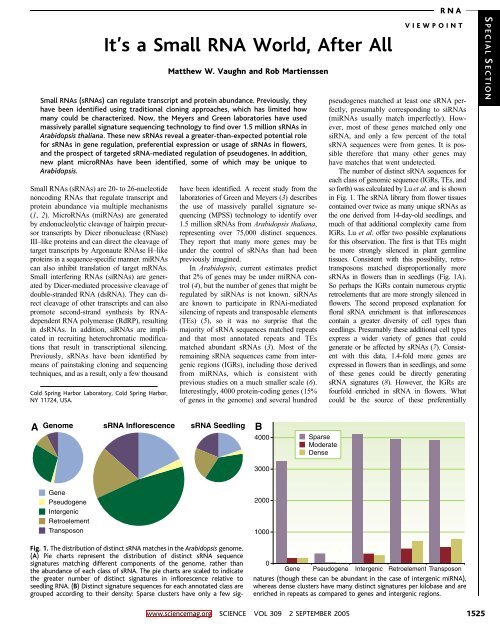THIS WEEK IN
THIS WEEK IN
THIS WEEK IN
You also want an ePaper? Increase the reach of your titles
YUMPU automatically turns print PDFs into web optimized ePapers that Google loves.
It’s a Small RNA World, After All<br />
Matthew W. Vaughn and Rob Martienssen<br />
Small RNAs (sRNAs) can regulate transcript and protein abundance. Previously, they<br />
have been identified using traditional cloning approaches, which has limited how<br />
many could be characterized. Now, the Meyers and Green laboratories have used<br />
massively parallel signature sequencing technology to find over 1.5 million sRNAs in<br />
Arabidopsis thaliana. These new sRNAs reveal a greater-than-expected potential role<br />
for sRNAs in gene regulation, preferential expression or usage of sRNAs in flowers,<br />
and the prospect of targeted sRNA-mediated regulation of pseudogenes. In addition,<br />
new plant microRNAs have been identified, some of which may be unique to<br />
Arabidopsis.<br />
Small RNAs (sRNAs) are 20- to 26-nucleotide<br />
noncoding RNAs that regulate transcript and<br />
protein abundance via multiple mechanisms<br />
(1, 2). MicroRNAs (miRNAs) are generated<br />
by endonucleolytic cleavage of hairpin precursor<br />
transcripts by Dicer ribonuclease (RNase)<br />
III–like proteins and can direct the cleavage of<br />
target transcripts by Argonaute RNAse H–like<br />
proteins in a sequence-specific manner. miRNAs<br />
can also inhibit translation of target mRNAs.<br />
Small interfering RNAs (siRNAs) are generated<br />
by Dicer-mediated processive cleavage of<br />
double-stranded RNA (dsRNA). They can direct<br />
cleavage of other transcripts and can also<br />
promote second-strand synthesis by RNAdependent<br />
RNA polymerase (RdRP), resulting<br />
in dsRNAs. In addition, siRNAs are implicated<br />
in recruiting heterochromatic modifications<br />
that result in transcriptional silencing.<br />
Previously, sRNAs have been identified by<br />
means of painstaking cloning and sequencing<br />
techniques, and as a result, only a few thousand<br />
Cold Spring Harbor Laboratory, Cold Spring Harbor,<br />
NY 11724, USA.<br />
have been identified. A recent study from the<br />
laboratories of Green and Meyers (3) describes<br />
the use of massively parallel signature sequencing<br />
(MPSS) technology to identify over<br />
1.5 million sRNAs from Arabidopsis thaliana,<br />
representing over 75,000 distinct sequences.<br />
They report that many more genes may be<br />
under the control of sRNAs than had been<br />
previously imagined.<br />
In Arabidopsis, current estimates predict<br />
that 2% of genes may be under miRNA control<br />
(4), but the number of genes that might be<br />
regulated by siRNAs is not known. siRNAs<br />
are known to participate in RNAi-mediated<br />
silencing of repeats and transposable elements<br />
(TEs) (5), so it was no surprise that the<br />
majority of sRNA sequences matched repeats<br />
and that most annotated repeats and TEs<br />
matched abundant sRNAs (3). Most of the<br />
remaining sRNA sequences came from intergenic<br />
regions (IGRs), including those derived<br />
from miRNAs, which is consistent with<br />
previous studies on a much smaller scale (6).<br />
Interestingly, 4000 protein-coding genes (15%<br />
of genes in the genome) and several hundred<br />
RNA<br />
VIEWPO<strong>IN</strong>T<br />
pseudogenes matched at least one sRNA perfectly,<br />
presumably corresponding to siRNAs<br />
(miRNAs usually match imperfectly). However,<br />
most of these genes matched only one<br />
siRNA, and only a few percent of the total<br />
sRNA sequences were from genes. It is possible<br />
therefore that many other genes may<br />
have matches that went undetected.<br />
The number of distinct sRNA sequences for<br />
each class of genomic sequence (IGRs, TEs, and<br />
so forth) was calculated by Lu et al. and is shown<br />
in Fig. 1. The sRNA library from flower tissues<br />
contained over twice as many unique sRNAs as<br />
the one derived from 14-day-old seedlings, and<br />
much of that additional complexity came from<br />
IGRs. Lu et al. offer two possible explanations<br />
for this observation. The first is that TEs might<br />
be more strongly silenced in plant germline<br />
tissues. Consistent with this possibility, retrotransposons<br />
matched disproportionally more<br />
sRNAs in flowers than in seedlings (Fig. 1A).<br />
So perhaps the IGRs contain numerous cryptic<br />
retroelements that are more strongly silenced in<br />
flowers. The second proposed explanation for<br />
floral sRNA enrichment is that inflorescences<br />
contain a greater diversity of cell types than<br />
seedlings. Presumably these additional cell types<br />
express a wider variety of genes that could<br />
generate or be affected by sRNAs (7). Consistent<br />
with this data, 1.4-fold more genes are<br />
expressed in flowers than in seedlings, and some<br />
of these genes could be directly generating<br />
sRNA signatures (8). However, the IGRs are<br />
fourfold enriched in sRNA in flowers. What<br />
could be the source of these preferentially<br />
S PECIAL S ECTION<br />
A Genome<br />
sRNA Inflorescence sRNA Seedling B<br />
4000 Sparse<br />
Moderate<br />
Dense<br />
3000<br />
Gene<br />
Pseudogene<br />
Intergenic<br />
Retroelement<br />
Transposon<br />
2000<br />
1000<br />
Fig. 1. The distribution of distinct sRNA matches in the Arabidopsis genome.<br />
(A) Pie charts represent the distribution of distinct sRNA sequence<br />
signatures matching different components of the genome, rather than<br />
the abundance of each class of sRNA. The pie charts are scaled to indicate<br />
the greater number of distinct signatures in inflorescence relative to<br />
seedling RNA. (B) Distinct signature sequences for each annotated class are<br />
grouped according to their density: Sparse clusters have only a few sig-<br />
0<br />
Gene Pseudogene Intergenic Retroelement Transposon<br />
natures (though these can be abundant in the case of intergenic miRNA),<br />
whereas dense clusters have many distinct signatures per kilobase and are<br />
enriched in repeats as compared to genes and intergenic regions.<br />
www.sciencemag.org SCIENCE VOL 309 2 SEPTEMBER 2005 1525
















